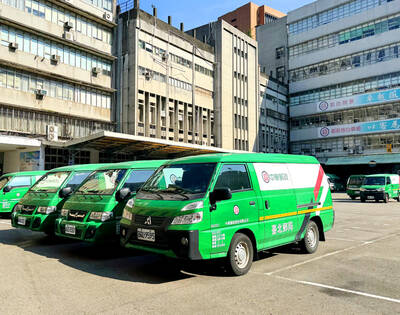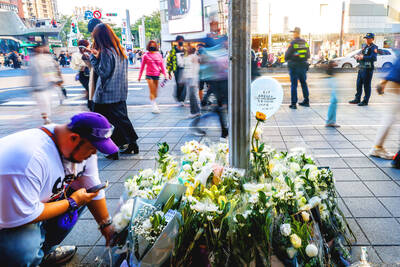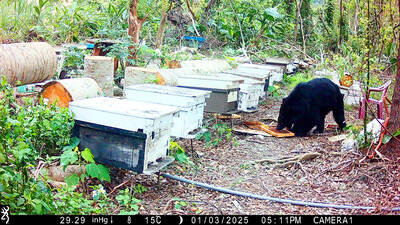Long before Portuguese sailors put "Formosa" on the world map, and long before Chinese people crossed the dark current to set up home here, this land was inhabited by Austronesian Aborigines for thousands of years. Multigenetic analysis reveals that Austronesian tribes arrived as early as 14,000 years ago.
According to Marie Lin (
"Even before Taiwan became an island, forefathers of Taiwan's indigenous peoples arrived in Taiwan in the late pleistocene ice age," Lin said after a conference at Mackay Memorial Hospital yesterday.
Lin had previously delivered the paper in June at an international conference on Human Migrations in Continental East Asia and Taiwan at the University of Geneva.
Lin's theory of the origin of Taiwanese Aboriginals sheds light on the role the island plays as a transition station for archaic hominid populations. In genetic and archaeological studies, the most recognized model on modern human origins suggests two routes out of Africa in prehistory. One is the northern route toward Europe and North Asia. The other is the southern coastal route from Africa toward East Asia and Oceania. It is on the southern route that Taiwan served as a midway hub for the earliest human migration.
"Genetically speaking, Taiwan is one of the most probable sources of the Austronesian family," said Toomas Kivisild, research fellow at the Department of Evolutionary Biology at the University of Tartu in Estonia, who found his study on the database in Lin's lab. Based on comparisons of genetic sequencing, Kivisild inferred that Polynesian migration is likely to have originated in Taiwan, followed by a later maturation and interaction phase in the islands that are now eastern Indonesia and Melanesia.
Kivisild's model demonstrated that while there is a genetic link between the indigenous Taiwanese and the ancestors of present-day Polynesian populations, there is no Austronesian lineage that could be traced back to a Neolithic migration from China.
The genetic evidence, however, is at odds with anthropological data that support the theory that there were contacts with China even in the Neolithic age.
In Taiwan, the Neolithic stage is represented by the oldest ceramic culture of the island, the Tapenkeng culture site in Pali (
"Based on comparison of pottery traits, it could be said that the region of the southeast coast of China, including Taiwan, is the Austronesian homeland," Tsang said.
"In the quest for origin, different disciplines have different compasses and road maps. At the edge of the knowable, every evidence has its own message," Tsang said to explain the discrepancy between the genetic and anthropological findings.
"Hopefully, as more clues come to light, one day the scientists, anthropologists and linguists will tell the same story of human beings, a story of where we all come from."

SHIPS, TRAINS AND AUTOMOBILES: The ministry has announced changes to varied transportation industries taking effect soon, with a number of effects for passengers Beginning next month, the post office is canceling signature upon delivery and written inquiry services for international registered small packets in accordance with the new policy of the Universal Postal Union, the Ministry of Transportation and Communications said yesterday. The new policy does not apply to packets that are to be delivered to China, the ministry said. Senders of international registered small packets would receive a NT$10 rebate on postage if the packets are sent from Jan. 1 to March 31, it added. The ministry said that three other policies are also scheduled to take effect next month. International cruise ship operators

HORROR STORIES: One victim recounted not realizing they had been stabbed and seeing people bleeding, while another recalled breaking down in tears after fleeing A man on Friday died after he tried to fight the knife-wielding suspect who went on a stabbing spree near two of Taipei’s busiest metro stations, Taipei Mayor Chiang Wan-an (蔣萬安) said. The 57-year-old man, identified by his family name, Yu (余), encountered the suspect at Exit M7 of Taipei Main Station and immediately tried to stop him, but was fatally wounded and later died, Chiang said, calling the incident “heartbreaking.” Yu’s family would receive at least NT$5 million (US$158,584) in compensation through the Taipei Rapid Transit Corp’s (TRTC) insurance coverage, he said after convening an emergency security response meeting yesterday morning. National

PLANNED: The suspect visited the crime scene before the killings, seeking information on how to access the roof, and had extensively researched a 2014 stabbing incident The suspect in a stabbing attack that killed three people and injured 11 in Taipei on Friday had planned the assault and set fires at other locations earlier in the day, law enforcement officials said yesterday. National Police Agency (NPA) Director-General Chang Jung-hsin (張榮興) said the suspect, a 27-year-old man named Chang Wen (張文), began the attacks at 3:40pm, first setting off smoke bombs on a road, damaging cars and motorbikes. Earlier, Chang Wen set fire to a rental room where he was staying on Gongyuan Road in Zhongzheng District (中正), Chang Jung-hsin said. The suspect later threw smoke grenades near two exits

The Forestry and Nature Conservation Agency yesterday launched a gift box to market honey “certified by a Formosan black bear” in appreciation of a beekeeper’s amicable interaction with a honey-thieving bear. Beekeeper Chih Ming-chen (池明鎮) in January inspected his bee farm in Hualien County’s Jhuosi Township (卓溪) and found that more than 20 beehives had been destroyed and many hives were eaten, with bear droppings and paw prints near the destroyed hives, the agency said. Chih returned to the farm to move the remaining beehives away that evening when he encountered a Formosan black bear only 20m away, the agency said. The bear